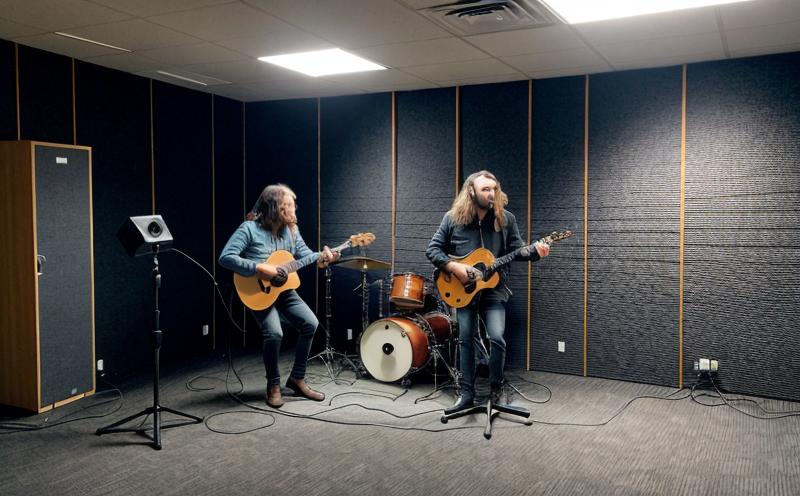ISO 3382-2 Measurement of Acoustic Parameters in Buildings
The ISO 3382-2 standard provides a comprehensive framework for measuring acoustic parameters within buildings. This test method is critical for ensuring that HVAC equipment operates efficiently and meets the noise control requirements specified by building codes and standards.
Acoustic testing, particularly under ISO 3382-2, involves several steps aimed at evaluating sound pressure levels (SPL), frequency spectrum, and other parameters within a controlled environment. The process begins with setting up the test chamber to replicate real-world conditions as closely as possible. This includes controlling variables such as temperature, humidity, and background noise.
Once the setup is complete, the HVAC equipment under test is installed in the chamber. The testing protocol involves measuring SPLs at various points around the equipment using calibrated microphones. Simultaneously, frequency response measurements are taken to assess how sound energy is distributed across different frequencies. These measurements help identify any potential issues with noise generation that could affect both indoor comfort and compliance.
The test results are analyzed against ISO 3382-2 criteria to determine whether the equipment meets specified standards for acceptable noise levels in residential, commercial, or industrial settings. Compliance is essential not only for meeting regulatory requirements but also for enhancing overall building performance by minimizing unwanted sound propagation.
Real-world applications of this testing method include verifying that newly developed HVAC systems meet expected performance levels during prototyping stages, ensuring existing installations remain compliant with updates to relevant regulations, and providing data necessary for continuous improvement in design iterations. By adhering strictly to the procedures outlined in ISO 3382-2, laboratories can provide credible evidence supporting claims made about a product's acoustical properties.
Understanding these nuances is crucial for stakeholders involved directly or indirectly with HVAC equipment manufacturing and installation processes. Compliance officers need reliable data to enforce adherence to local regulations effectively; R&D engineers must ensure their innovations are practical solutions rather than theoretical constructs; while procurement teams can leverage such insights when selecting suppliers capable of delivering quality products.
To summarize, ISO 3382-2 plays a vital role in validating HVAC equipment performance through rigorous acoustic measurement techniques. Its implementation ensures that buildings achieve optimal acoustical comfort levels, thereby contributing positively towards occupant well-being and energy efficiency goals.
Why It Matters
The importance of accurate acoustic testing cannot be overstated when considering its impact on human health, comfort, and productivity. Inadequate attention to noise control measures can lead to significant discomfort among occupants, potentially resulting in reduced work performance or even adverse physical effects like stress-related illnesses.
- Enhanced Indoor Comfort: Properly designed HVAC systems contribute significantly to creating comfortable indoor environments free from excessive noise pollution. This enhances the overall quality of life for building inhabitants who spend considerable time indoors.
- Regulatory Compliance: Many jurisdictions have stringent regulations governing allowable noise levels in various types of buildings. Adhering to these standards ensures compliance with legal requirements, avoiding potential penalties and fines.
- Sustainability Goals: Quiet HVAC equipment consumes less energy compared to louder counterparts because they do not require additional power inputs to overcome higher resistance caused by turbulent airflow patterns associated with high noise outputs.
Incorporating ISO 3382-2 into the evaluation process helps manufacturers produce quieter, more efficient products that contribute positively towards achieving broader sustainability objectives. Ultimately, this translates into better living and working conditions for everyone involved.
Customer Impact and Satisfaction
Environmental and Sustainability Contributions
The environmental benefits of accurate acoustic testing extend beyond immediate improvements in indoor comfort; they also have far-reaching implications for global sustainability efforts. Lower noise levels contribute positively towards reducing overall energy consumption, which directly translates into lower greenhouse gas emissions.
Incorporating ISO 3382-2 into the testing protocols emphasizes the importance of sustainable practices throughout the lifecycle of HVAC equipment. This aligns with broader industry trends toward greener manufacturing processes and product lifecycles. By focusing on reducing noise pollution, manufacturers can contribute to creating healthier urban environments while simultaneously addressing climate change concerns.
Moreover, compliant products have longer service lives compared to their less efficient counterparts. Longer-lasting equipment reduces waste generation and resource depletion associated with frequent replacements. This approach supports circular economy principles by promoting the reuse of valuable materials within existing systems rather than discarding them after short usage periods.
Ultimately, adhering to standards such as ISO 3382-2 fosters a culture of responsibility among stakeholders involved in HVAC equipment manufacturing and installation processes. It encourages continuous improvement in design iterations based on reliable data derived from thorough testing procedures.





